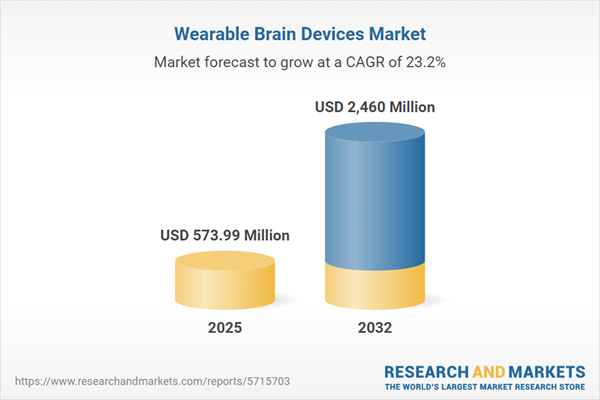Speak directly to the analyst to clarify any post sales queries you may have.
As neurotechnology advances, the wearable brain devices market is undergoing rapid change. Senior leaders are closely watching how sensor innovation, artificial intelligence, and evolving regulatory standards influence the adoption and competitive landscape of these transformative devices for healthcare, research, and consumer applications.
Market Snapshot: Wearable Brain Devices Market
The Wearable Brain Devices Market demonstrated strong growth, expanding from USD 464.88 million in 2024 to USD 573.99 million in 2025. With a CAGR of 23.18%, projections indicate the market will reach USD 2.46 billion by 2032, signalling robust adoption and diverse application opportunities.
Scope & Segmentation of the Wearable Brain Devices Market
This analysis provides a strategic breakdown of the key sectors and regional dynamics shaping the wearable brain devices market for decision-makers considering investments or partnerships:
- Technology: Invasive brain implants, deep brain stimulators, noninvasive EEG (dry and wet technologies), functional near-infrared spectroscopy, and magnetoencephalography solutions are powering next-generation neurotechnology development and monitoring.
- Application: Consumer use cases extend into gaming, fitness tracking, meditation, and sleep monitoring, while clinical implementations focus on diagnostic testing, cognitive assessment, epilepsy detection, motor and neurological rehabilitation, and therapies for depression and stroke. Research applications span academic and corporate settings, supporting further innovation.
- End User: Key groups include consumers seeking digital wellness, healthcare providers such as clinics, neurology practices, rehabilitation centres, and hospitals, as well as research institutes expanding their neuroscience capabilities.
- Distribution Channel: Products reach markets through direct B2B sales for institutional procurement, OEM partnerships supporting custom development, online e-commerce retailers for broader access, electronics outlets, and specialty stores serving targeted user groups.
- Price Range: A broad selection accommodates various budgets with economy, mid-range, and premium product options.
- Geographical Regions: Coverage includes the Americas—North and Latin America—Europe, the Middle East & Africa, and Asia-Pacific, each contributing unique adoption trends and manufacturing strengths.
- Company Coverage: Representative organizations shaping market dynamics include NeuroSky Inc., EMOTIV Inc., InteraXon Inc., Advanced Brain Monitoring Inc., g.tec medical engineering GmbH, OpenBCI LLC, MindMaze SA, Cognionics Inc., Halo Neuroscience Inc., and NextMind SA.
Key Takeaways for Senior Decision-Makers
- Recent advancements in sensor technology and real-time artificial intelligence are driving fresh neurotechnology use cases, both in clinical environments and among tech-forward consumers.
- Strategic partnerships across medical technology firms, academic vendors, and technology providers are accelerating product introductions and helping businesses maintain strong differentiation.
- Transitioning toward modular device designs and open-standard frameworks increases platform interoperability and enables adaptable solutions in response to evolving clinical and consumer needs.
- Policy shifts in regulatory and tariff environments are impacting how companies manage supply chains and source components, with direct implications for project timelines and market responsiveness.
- Growth patterns vary by region; Asia-Pacific specializes in efficient mass production and cost-effective scaling, while leaders in the Americas focus on R&D investment, and EMEA regions emphasize regulatory compliance to support adoption in diverse use cases.
- Product and channel diversification, across both established and emerging segments, positions organizations to effectively address shifting market demands as user expectations for neuro-enabled products rise.
Analyzing Tariff Impact and Supply Chain Adjustments
Revised US tariff policies introduced in 2025 have changed the cost structure for manufacturers involved in the wearable brain devices segment. Organizations have responded by increasing investments in local partnerships, adapting supply chains to reduce risks, and focusing on domestic sourcing for critical microelectronics and specialized components. Flexible design approaches and proactive engagement with distribution channels have supported continued product availability and competitive agility throughout tariff-driven market shifts.
Methodology & Data Sources
The market findings are underpinned by a comprehensive approach combining expert interviews, practitioner feedback, and up-to-date secondary sources including white papers, patent filings, and regulatory briefings. This framework ensures data accuracy and provides actionable insights for decision-makers in the neurotechnology market.
Why This Report Matters
- Equips senior leaders with market intelligence needed to assess growth opportunities, technology partnerships, and regulatory implications in the wearable brain devices space.
- Enables informed strategic planning through detailed segmentation covering technology use, buyer groups, distribution, and price points.
- Supports risk management and investment prioritization by providing insights on supply chain resilience and evolving competition in global neurotechnology ecosystems.
Conclusion
The wearable brain devices market continues to transform both human-computer interaction and modern healthcare. Organizations remaining alert to shifting trends and regulatory conditions can secure valuable positions within this expanding sector.
Additional Product Information:
- Purchase of this report includes 1 year online access with quarterly updates.
- This report can be updated on request. Please contact our Customer Experience team using the Ask a Question widget on our website.
Table of Contents
3. Executive Summary
4. Market Overview
7. Cumulative Impact of Artificial Intelligence 2025
Companies Mentioned
The companies profiled in this Wearable Brain Devices market report include:- NeuroSky Inc.
- EMOTIV Inc.
- InteraXon Inc.
- Advanced Brain Monitoring Inc.
- g.tec medical engineering GmbH
- OpenBCI LLC
- MindMaze SA
- Cognionics Inc.
- Halo Neuroscience Inc.
- NextMind SA
Table Information
| Report Attribute | Details |
|---|---|
| No. of Pages | 193 |
| Published | October 2025 |
| Forecast Period | 2025 - 2032 |
| Estimated Market Value ( USD | $ 573.99 Million |
| Forecasted Market Value ( USD | $ 2460 Million |
| Compound Annual Growth Rate | 23.1% |
| Regions Covered | Global |
| No. of Companies Mentioned | 11 |









